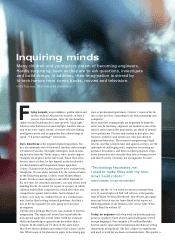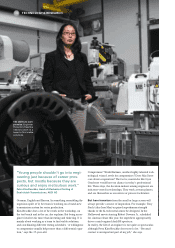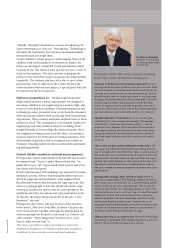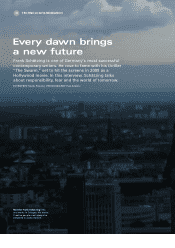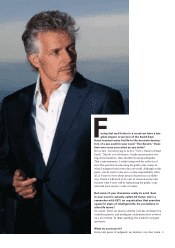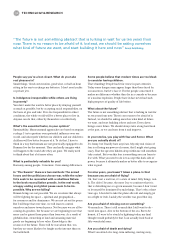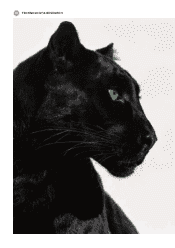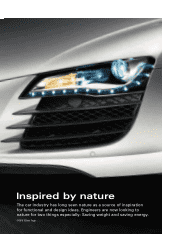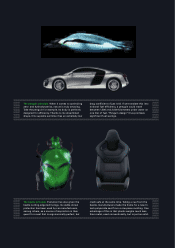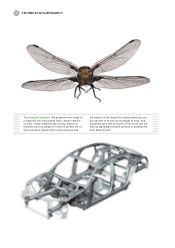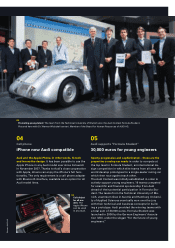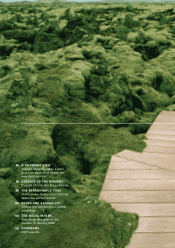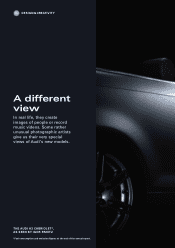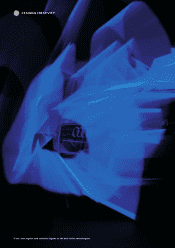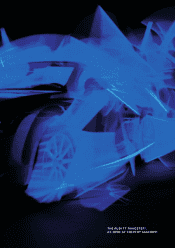Audi 2007 Annual Report Download - page 81
Download and view the complete annual report
Please find page 81 of the 2007 Audi annual report below. You can navigate through the pages in the report by either clicking on the pages listed below, or by using the keyword search tool below to find specific information within the annual report.
79
TECHNOLOGY& RESEARCH
owes part of its appeal to the world of flora and fauna: The
transmission supports, inspired by the design of the giant
water lily, or radar sensors that were inspired by the orienta-
tion system found in bats.
This principle presents a particular technical challenge
for the creation of sensitive characteristics. In order to feel
their way around, these nocturnal animals emit ultrasonic
squeaks inaudible to the human ear 170 times a second, using
the returning echo to differentiate between potential prey
and their own kind and recognize obstacles. They can even
decode chaotic background noise. Ultrasound is also used by
whales and dolphins – and now in cars, too, for example in
parking sensors.
The newly introduced Audi side assist helps drivers when
changing lanes. Radar sensors built into the rear bumper, mon-
itor blind spot areas. If the sensor spots a vehicle, the driver is
informed via an LED integrated into the wing mirror.
For the development of new tires, the tire industry has
looked at what amounts to half a zoo. Cats, polar bears, spi-
ders and frogs all act as models for tire construction, com-
pounds and profiles. Big cats are a good example. Despite
their incredible speed, they can change direction or come to
a halt in a split second. The secret? Their paws broaden on
impact. Tires incorporating this technology are now on the
market. Although narrow, they bring additional rubber into
contact with the road surface on braking, thus shortening
the stopping distance.
The beauty of nature can also be inspiring. For example, the
lighting functions in the Audi R8 are performed by LEDs.
Naturally, this also requires corresponding advances in design.
Consequently, the R8’s headlights, for instance, are modeled
along the lines of an open pine cone – a series of reflector
shells arranged concentrically one behind the other. The
distinctive shape of the lights is also reminiscent of the mes-
merizing eyes of a panther.
Sharkskin is another example of evolution at its best. It
disproves the obvious principle that the smoother a surface, the
faster it can move. A shark’s body is completely covered with
miniscule plates which form microscopic longitudinal grooves.
This structure ensures that the water glides over the shark’s
body with less resistance. Professional swimmers now wear
body suits made from imitation sharkskin, in order to swim
each length of the pool a few hundredths of a second faster. The
grooves on ships are also a clever strategy to help prevent bar-
nacle and mussel growths. The same principle has also been
adopted to laminate aircraft on an experimental basis. The
he Gentoo penguin can swim underwater at a top
speed of seven meters per second. In terms of air
speed, this translates into over 100 meters per second –
the force of a hurricane. Thanks to their streamlined shape,
these creatures are able to swim up to 100 kilometers per day.
All they need as fuel for this remarkable daily performance is
a stomach full of small shrimp. “Expressed in notional fossil
fuel, this means that on one liter of fuel, a penguin could swim
between 1,500 to 2,000 kilometers,” explains Werner Nachti-
gall, Germany’s leading bionics expert and director of the
BIOKON competence center at Saarland University.
Faced with this wonder of fuel efficiency, it is all too easy
to see why a car manufacturer like Audi would look long and
hard at bionics. This field of research, whose name has been
coined from biology and technology, deals with applying the
structural, operational and developmental principles of bio-
logical systems in a technical context. “But it’s not about
straightforward copying. The idea that nature has prepared
blueprints for technology will get you nowhere,” says Nachti-
gall. “In nature, bionic principles have been able to develop
more or less unrestricted,” comments Dr. Klaus Koglin, Head
of Technology Development at Audi. All of Audi’s engineers,
however, need to achieve a delicate balance between design,
lightweight construction, safety, vehicle handling, comfort and
profitability in their creative solutions. Consequently, it is no
easy task to transpose a structural design found in nature into a
technical solution. “In reality, transferring an active bionic
principle is far harder than just recognizing it, as it requires
the cooperation of almost all partners within the process
chain, that means designers, engineers, planners, process
managers and technology developers,” says Koglin.
One of the most popular examples of bionics is the so-
called lotus effect. A microscopically small structure on the
leaf of a lotus flower prevents the adhesion of droplets of
water or dust particles. The transfer of this effect to industrial
research has given us self-cleaning roof tiles and marquees,
as well as washstands that always stay clean. Needless to say,
Audi is working on dirt-repellent nanopaint. At Audi’s head-
quarters in Ingolstadt, construction methods have been
enhanced by bionic concepts since the 1970s. Take the devel-
opment of the innovative Audi Space Frame, for example.
“Every engineer knows the importance of firm knots and the
supporting effect of light tensile surfaces between them,” says
Dr. Claus Haverkamp, Head of Car Body Structure Develop-
ment at Audi. “Researchers have copied a great deal from
nature, such as the structure of the bamboo plant, the dragon-
fly or the water lily.” Here, high rigidity and solidity, maxi-
mum flexibility and low weight combine to form the perfect
mix of characteristics.
Bionics stimulates creativity and the drive to innovate. “Bionic
principles often open up new perspectives, other than the
traditional approaches adopted by engineers,” explains
Haverkamp. The advantage here is that nature has honed its
technological prowess over millions of years. The Audi A8
T
“Transferring an active bionic principle
is far harder than just recognizing it.”
Dr. Klaus Koglin, Head of Technology Development, AUDI AG


